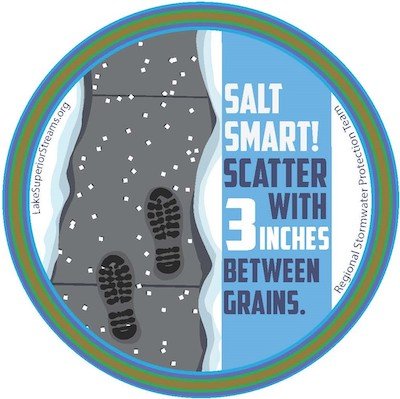Winter sidewalks
Keep them safe for people, and safe for lakes
Salt pollution threatens our lakes
Did you know that the chloride found in sidewalk salt and de-icers is becoming a major contaminant in Bde Mka Ska, Lake of the Isles, Powderhorn Lake, Minnehaha Creek and other Minneapolis lakes and streams? Salt harms fish and other aquatic life, makes our drinking water salty, irritates the paws of pets, and corrodes vehicles and infrastructure.
Melting snow washes salt into our lakes and rivers. Chloride does not break down over time and once present it’s nearly impossible to remove.
The good news is that we can reduce salt use while still maintaining winter sidewalk safety.
What can residents do?
Shovel. Clear walkways before snow gets compacted or turns to ice. Shovel early and often. Salt is rarely needed once snow is removed. Do not apply salt to dry pavement.
Scatter. To prevent slippery spots try sand or traction grit. Use salt sparingly and only where critical (i.e. icy steps). More salt does not mean more melting. Aim for 3 inches of space between salt granules (a 12-oz coffee cup can cover 10 sidewalk squares).
Switch. Common de-icers do not melt ice below 15° Fahrenheit (pavement temperature), so should not be applied in very cold temperatures. Use grit or sand instead.
Sweep. Clean up leftover salt and sand on dry pavement, so it doesn’t wash into the storm sewer (too much sand pollutes too). Reuse it as needed.
Talk to your property manager. Look for signs of over-salting: a dense covering of salt, salt on bare pavement or on snow, or salty residue on pavement or indoor floors. If you don’t see these, thank your manager!
Things to note
There are no environmentally friendly salts or de-icers. Nearly all contain chloride or other chemicals that cause similar damage. This includes “ecofriendly” and “pet/paw friendly” products.
Everything that washes down a storm drain ends up in a nearby lake, creek, or wetland.
Just one teaspoon of salt is enough to permanently pollute 5 gallons of water.
Thick ice can be very difficult to remove once it builds up and may require an ice chisel.
Take the Salt mini-course from the City of Minneapolis
What can property managers do?
Select the right contractor or maintenance staff
Ensure they have the capacity to clear your property promptly after a storm. Timely snow removal is the most important tool for minimizing hours spent on snow management.
When soliciting bids for winter services, add a requirement for Smart Salting certification for anyone applying salt on your property.
Never use a contractor that bills by the ton, gallon or pound of salt applied because it encourages over-application.
Make sure your contractor or maintenance staff know how much and what types of deicer they apply.
MPCA includes a model contract in their Smart Salting for Property Managers manual (PDF).
Monitor regularly for oversalting or incorrect storage of snow and salt.
What about safety?
Sometimes, people oversalt out of fear of litigation – even though additional salt does not increase safety. For more information see the section on liability in the Smart Salting for Property Managers manual (PDF) including a winter maintenance policy template. The document recommends making a winter maintenance plan, and then following the plan and documenting your actions.
Save on stormwater bills
The City of Minneapolis offers a 30% reduction of commercial stormwater charges for property owners who complete an Advanced Stormwater Management Plan. For more information, search for “stormwater credits” on the city website or visit: https://www.minneapolismn.gov/resident-services/utility-services/stormwater/
Resources
Salt mini-course from the City of Minneapolis
https://www2.minneapolismn.gov/government/programs-initiatives/environmental-programs/salt/
Smart Salting training from MPCA
https://www.pca.state.mn.us/water/smart-salting-training
The MN Pollution Control Agency provides this training and certification for Property Managers and public and private winter maintenance professionals.
Use this tool to determine where opportunities exist to improve practices, make reductions in salt use, and track progress
Smart Salting for Property Managers manual (PDF, 96 pgs)
Signage and fact sheets for sharing, from the Mississippi Watershed Management Organization


